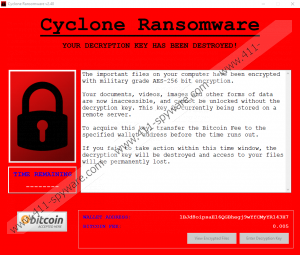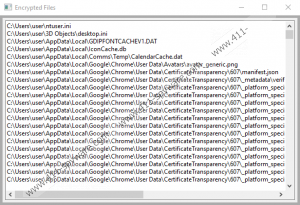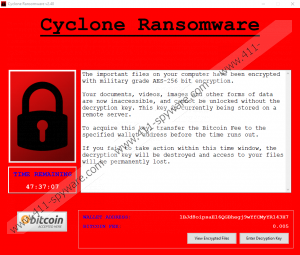Cyclone Ransomware Removal Guide
Cyclone Ransomware is a destructive computer infection that takes data hostage and demands for a ransom fee of 0.005 Bitcoin. The infection has been noticed in mid-December 2017 and is also known to have targeted the Intel 386, originally known as 80368, and some later processors. The Cyclone threat is built using the Pyphon programming language, which was used to create threats such as HollyCrypt, Locker, CryPy and some other threats. Cyclone Ransomware displays a visual warning informing a victim that all files are encrypted using AES-256 bit encryption and that decryption is possible only after submitting the ransom given at the bottom of the warning. The requirement to pay for the decryption key should be disregarded, because the money submission does not guarantee a fix. Instead of paying up, it is essential to remove Cyclone Ransomware and shield the system from future malware attacks.



How does Cyclone Ransomware work?
Cyclone Ransomware is a threat that arrives at a computer as an archive file and is extracted once downloaded to the PC. All the files that are necessary for the ransomware to operate are extracted in a folder in the %TEMP% directory. An analysis of Cyclone Ransomware has revealed that it targets 167 file formats, including .jpg, .png, .wav, .mp3, to mention just a few. Compared to other ransomware infections, the targeted number of file extensions is relatively small, but that does not change the fact that Cyclone Ransomware can encrypt data. In addition to the fixed number of extensions, the Cyclone malware also has a file size limit for encryption which is 2048 bytes and a time countdown of 48 hours. When the deadline passes, it is impossible to carry out decryption through the user interface of the ransomware.
Cyclone Ransomware is created to keep its victims under pressure, which is done by adding an auto-run component to the Windows Registry. Every time the computer boots up, the infection loads its interface encouraging the victim to take action towards data decryption.
Victims are required to make a payment in Bitcoin, which is a digital currency that is not owned or governed by any central issuer. Over the last few years, Bitcoin has become the currency of cyber crooks because of the anonymity of transactions, which are barely traceable. Security experts and law enforcement agencies working to fight cyber crime advise victims against paying up because the encrypted data is very often non-decryptable.
How to prevent ransomware?
Ransomware can be spread in several ways, and the latest commonly used methods are phishing emails and poor RDP configurations. In order to minimize chances for ransomware threats to access your computer, it is essential to be attentive to the content sent to you by email and to RDP connections attempting to access your device. Additionally, avoiding freeware sharing websites and software promoted on those websites is also important, not to mention the fact that a reputable system security program should be always running on.
How to remove Cyclone Ransomware?
Removing a computer infection might seem to be challenging if you do not have technical skills. It is possible to remove Cyclone Ransomware manually without our removal guide given below, but you should bear in mind that you make all those changes at your own risk. All that you have to do is delete recently downloaded files from the directories to which downloaded files are saved. Additionally, to put an end to the display of the user interface, the malicious registry value has to be deleted from the registry. All of this can be done for you by a professional security program. Implementing a reputable anti-malware program is highly advisable so that you can be sure that the system is not affected by any other harmful files or programs. Every computer without a security tool connected to the Internet becomes an easy target for malware, so, if you do not become a statistic, take action right now.
How to remove Cyclone Ransomware
- Check the desktop for recently downloaded files and delete questionable files.
- Access the Downloads and %TEMP% directory and delete files that arouse suspicion.
- Press Win+R and type in regedit.
- Click OK.
- Follow the path HKCU\SOFTWARE\Microsoft\Windows\CurrentVersion\Run\Crypter and delete the malicious registry value launching the malware.
Cyclone Ransomware Screenshots:



Cyclone Ransomware technical info for manual removal:
Files Modified/Created on the system:
| # | File Name | File Size (Bytes) | File Hash |
|---|---|---|---|
| 1 | fe26c46a899d17b6e7447e40b5de873e8fe9a7157fad0543e0b2e331564dafcd.exe | 9852657 bytes | MD5: 1cf430ee60128800e0da9b9836f3ffd6 |
Memory Processes Created:
| # | Process Name | Process Filename | Main module size |
|---|---|---|---|
| 1 | fe26c46a899d17b6e7447e40b5de873e8fe9a7157fad0543e0b2e331564dafcd.exe | fe26c46a899d17b6e7447e40b5de873e8fe9a7157fad0543e0b2e331564dafcd.exe | 9852657 bytes |

